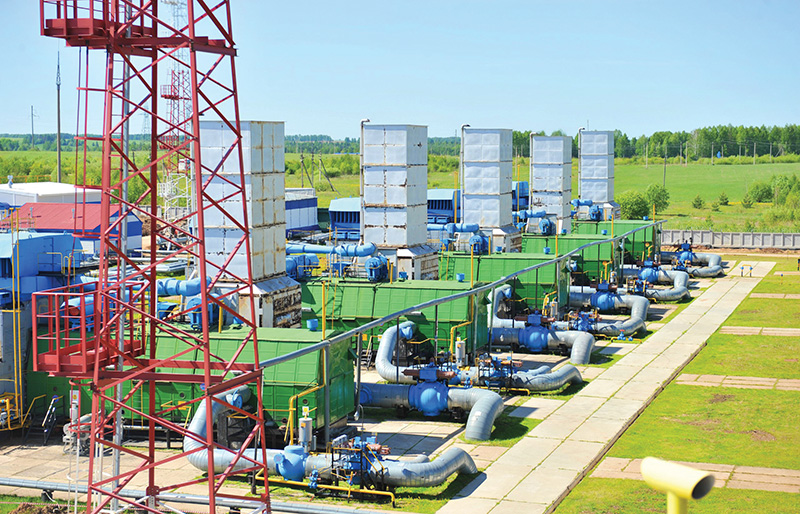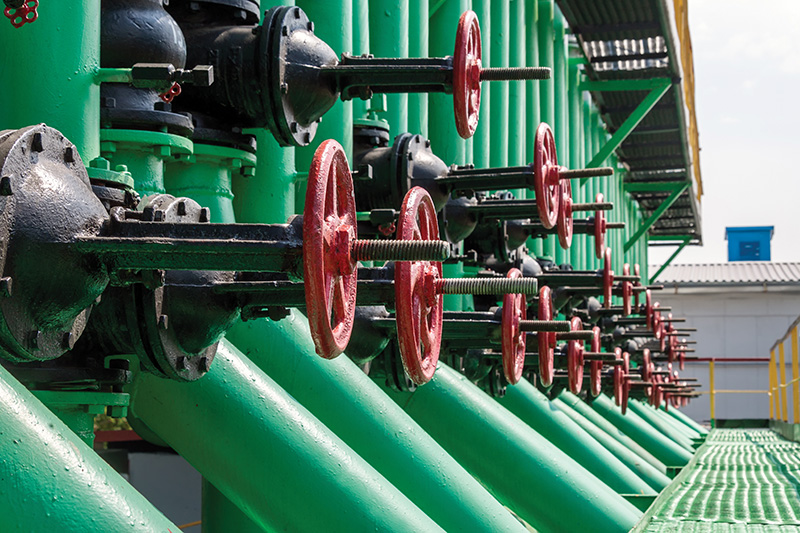September 2022, Vol. 249, No. 9
Features
Compression Stations: The Long Road to Commissioning
By Amin Almasi, Mechanical Engineer
(P&GJ) — Commissioning involves the use of a disciplined, systematic methodology to convert the constructed compressor station into an integrated and operational unit within a gas transmission system.
This process should be implemented in a safe and efficient manner within a defined time frame and budget. The successful operation of a compressor station strongly depends on the quality of three stages of the commissioning: pre-commissioning, core commissioning and startup. New guidelines, latest lessons learned and modern practical notes must be addressed.
There is little literature published on commissioning and startup issues, and there have been significant shortages of good commissioning personnel worldwide, particularly for compressor stations.
In many cases, the trial-and-error approach during commissioning continues to be a common approach. However, suggestions made in this article should save valuable time during the process.
Preparation, which includes development of a commissioning plan, preparation of commissioning documentations, development of operating procedures and handover procedures, is a large portion of commissioning time.
Implementation of commissioning is the most critical part of a compressor station project, which could include acceptance tests, cleaning activities, pre-commissioning, commissioning punch-listing, core commissioning activities and handover to the operation.
The last stage of a commissioning is the closeout, which consists of close-out reservations, complete as-commissioned document markups, the assistance to continued operation, troubleshooting and the closedown. Commissioning consists of the following three stages:
- Pre-commissioning, the entire process at the end of the construction and installation phase, prepares a compressor station to move to the core (main) commissioning phase.
- Core (main) commissioning stage is when various systems of a station are placed into initial operation.
- Startup takes place when the compressor station is brought into actual operation.
Based on various reports, the machinery commissioning stage is extremely critical for any compressor station project. In many cases, compressor packages cannot be properly operated at defined operation conditions because of commissioning problems. This article provides guidelines to help get machinery commissioned, started and operational.
In simple terms, commissioning is a series of checks, tests and final activities that confirm a compressor station is fit for operation. The key is a standardized and systemized approach to commissioning.
Station Commissioning
Key topics related to the commissioning include:
- Flushing and cleaning
- Systems assessment, along with calibrations and adjustments
- Procedures and protocols establishment, particularly those related to startup, normal shutdown and emergency shutdown
- System configuration and instrument/control system checks, including verification of alarms and trips
Opinions are divided over life expectancy of compressors and equipment within compressor stations. However, there is no doubt a proper commissioning is one of the most important factors for long-term, trouble-free operation.
The maintenance service period for a clean service compressor could be many years if the design is commissioned properly. For instance, the maintenance service period for electric motor-driven centrifugal compressors in clean gas services could be four to six years. For gas turbine-driven compressors, the selected gas turbine usually defines the service period, which could be one or two years.
For a poorly commissioned industrial machinery package, the life expectancy could run less than a year. Many failures in compressor stations could be prevented by a better condition monitoring system. An important stage for any compressor station commissioning is to make the condition monitoring system fully operational.
An essential element in the commissioning stage is inspection and verification of spare parts. Based on experience, about 4% to 7% of all spare components could be flawed; parts replacement may be required during commissioning. In some rare cases, a minor repair could be needed on equipment, machinery or facilities during commissioning. All fabrication and repair procedures should be in-hand for this stage.
The most useful guidelines for compressor station commissioning involve practical issues related to design, material and fabrication defects; assembly and installation errors; and off-design operations or errors in operation.
This third potential problem—errors in operation—is responsible for a large portion of failures at compressor stations. Unintended conditions, such as temperature, pressure, velocity and load, have caused many difficulties, even resulting in catastrophic failures.
Commissioning Staff
The commissioning team should include experts with different backgrounds, such as compressor experts, instrument engineers, process experts, control specialists, electrical engineers and operation specialists. A shortage of skilled workers is a sad reality in the commissioning sector.
A commissioning staff should be familiar with all site-specific regulations, codes, specifications, procedures and work instructions. In other words, even the most experienced commissioning experts and engineers should read and understand documents, manuals and instructions.
Each commissioning engineer is the manager of a team of other engineers and technicians for an assigned commissioning task; the team is responsible for some packages and systems. It is difficult to give a general rule on the number of assigned systems to each commissioning team.
Each commissioning engineer and his team normally can handle four to 10 systems or packages, depending on complexity, size and details of packages and systems.
Operation and maintenance staff presence is usually encouraged. This helps for a smooth handover to the operation team; it also ensures the operations team retains all lessons learned through commissioning.
In addition to the operations team, the maintenance team should be made fully aware of the nature and details of compressor packages and compressor station facilities.
Commissioning Budget
As a rough estimate, commissioning for a compressor station can run 3.5% to 4.5% of the total capital cost. The commissioning budget typically includes 65% to 75% for manpower. Contingency for engineering of commissioning modifications is a significant factor and could be as much as 15% to 30% of total commissioning budget.
On occasion, commissioning could require special instruments or rental equipment, with significant costs incurred. Examples include instruments for site performance tests, equipment for cleaning services and special safety equipment. Additionally, photography plays an important part in commissioning.
Safety, Management
Commissioning representatives should attend various safety functions, such as hazard and operability (HAZOP) gatherings and the pre-startup safety review (PSSR). PSSR is the last opportunity to catch and solve any safety issue before startup.
Another important safety requirement is that no equipment can be brought into service until its registration, documentations and safety checks have been completed.
There are always constrains of fast-track, subprojects in commissioning of any compressor station, with many changes usually required during commissioning. Any hidden defect or issue of the design, manufacturing, delivery and installation stages should be resolved or corrected in the commissioning phase.
Management of change (MOC) requires a systematic, sound procedure. Changes could present many safety and reliability issues to compressor packages and the compressor station if not managed using a robust MOC procedure.
Priority, Schedule
The end phase of the installation of a compressor station is a critical point and can present some scheduling challenges. Site installation teams should invest time and rearrange priorities in a way that assists commissioning activities.
During the final stage of compressor station installation, the commissioning manager should generally give the whole organization its directions. At this stage, the compressor station piping and instrumentation diagrams (P&IDs) become the main reference for checking the installation and construction.
At the end of the installation and construction phase (85% to 90% completion), the site group should adopt a change from its installation philosophy to an approach needed for the commissioning.
Pre-commissioning activities, and subsequently commissioning activities, should be started in a timely manner. It should not be too early since having a commissioning team involved in construction could be problematic. All engineering and installation changes should be implemented before the start of pre-commissioning activities to avoid re-works.
Pre-commissioning checks should not be started early because changes and modifications can occur that require rechecking. On the other hand, the commissioning team should be involved in final completion activities, tests and last-stage inspections.
For the commissioning, a backward approach is usually preferred. In this way, the completion order could be:
- Power, light, utility, water, air and similar, including power generation and utility packages
- Control systems
- Gas discharge system (pipeline) or recycle loop for start-up and initial operation
- Main units, including compressor packages
- Gas suction system (pipeline)
Reprioritizing is the key for a successful and timely commissioning of a compressor station. One of the worse scenarios is at 90% of installation, the team becoming busy with systems, machineries, packages and units not within the required early systems to be handed over and commissioned. The correct prioritization lays the foundation for success.
Commissioning engineers should be involved in installation and construction activities during the last 15% to 20% of the work, particularly observing leak and performance tests, and final completion activities. Otherwise, a considerable amount of time will be lost.
Priority should be given to units and items that add value and can be used for the commissioning of other systems or handed over to operations. It is important that the construction team follow the commissioning plans and priorities.
Natural flow of commissioning work based on the backward concept should be established so any system being completed helps with an efficient startup. Priority is a significant factor in any commissioning; it shows how the commissioning team plans to approach the commissioning and startup. It should be clearly discussed and documented.
As an example, in many compressor stations, the lighting system usually is one of the last systems delivered, probably because of the low priority associated with it. This is not a good, safe practice. It is extremely important that all lighting systems be ready and operational as soon as possible. Such systems can offer great benefits and safety for entire commissioning and startup activities. Working in the dark or using temporary lighting (with long-exposed cables) causes risks.
Great care is needed for commissioning time schedules. For commissioning and startup schedules, all steps should be predicted, and proper time should be allotted for each step.
Many completion and commissioning activities, such as last-minute corrections, modifications in facilities or packages, or changes in piping can alter machine alignment. The proper time should be allowed for the realignment of machineries – something that is often neglected.
Recommissioning activity can be another forgotten item in commissioning planning. If machinery, such as a compressor package, has been commissioned, this package should be recommissioned when the package is hooked up with all other systems.
Only after the integration can a compressor package be tested in a situation that resembles the actual working full-load condition. Proper time and resource allowances should be respected for recommissioning of different packages.
The time required for the oil flushing of machineries is usually underestimated. It often requires two or three times as long as common estimates. For special and complex lubrication oil systems, a complete and high-quality oil flushing could take three to 12 days.
Correct time frames should be set for cleaning checks, internal inspections and borescoping. The machinery package that is handed over from construction to commissioning personnel should be inspected for cleanliness. Usually, facilities and machinery are not as clean as required during the handover.
Author: Amin Almasi is a lead mechanical engineer specializing in rotating equipment and pipelines in Australia. He is a chartered professional engineer of Engineers Australia (MIEAust CPEng – Mechanical) and IMechE (CEng MIMechE) and holds master’s and bachelor’s degrees in mechanical engineering.







Comments